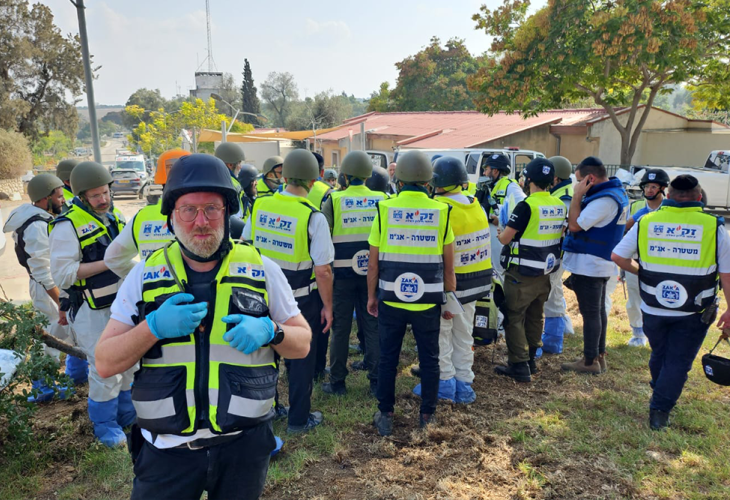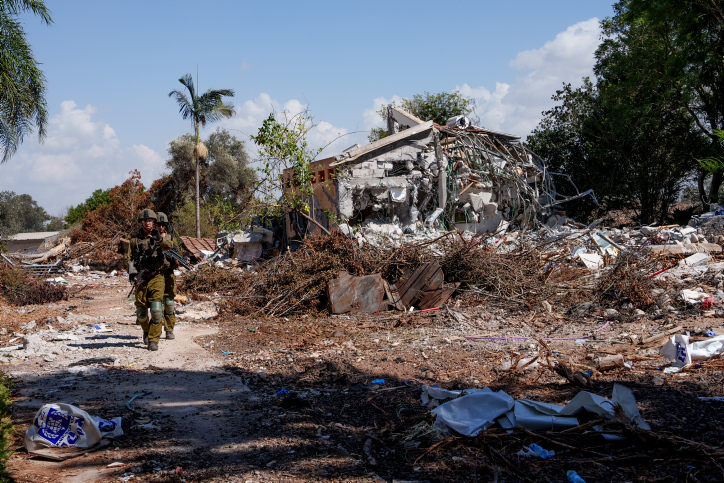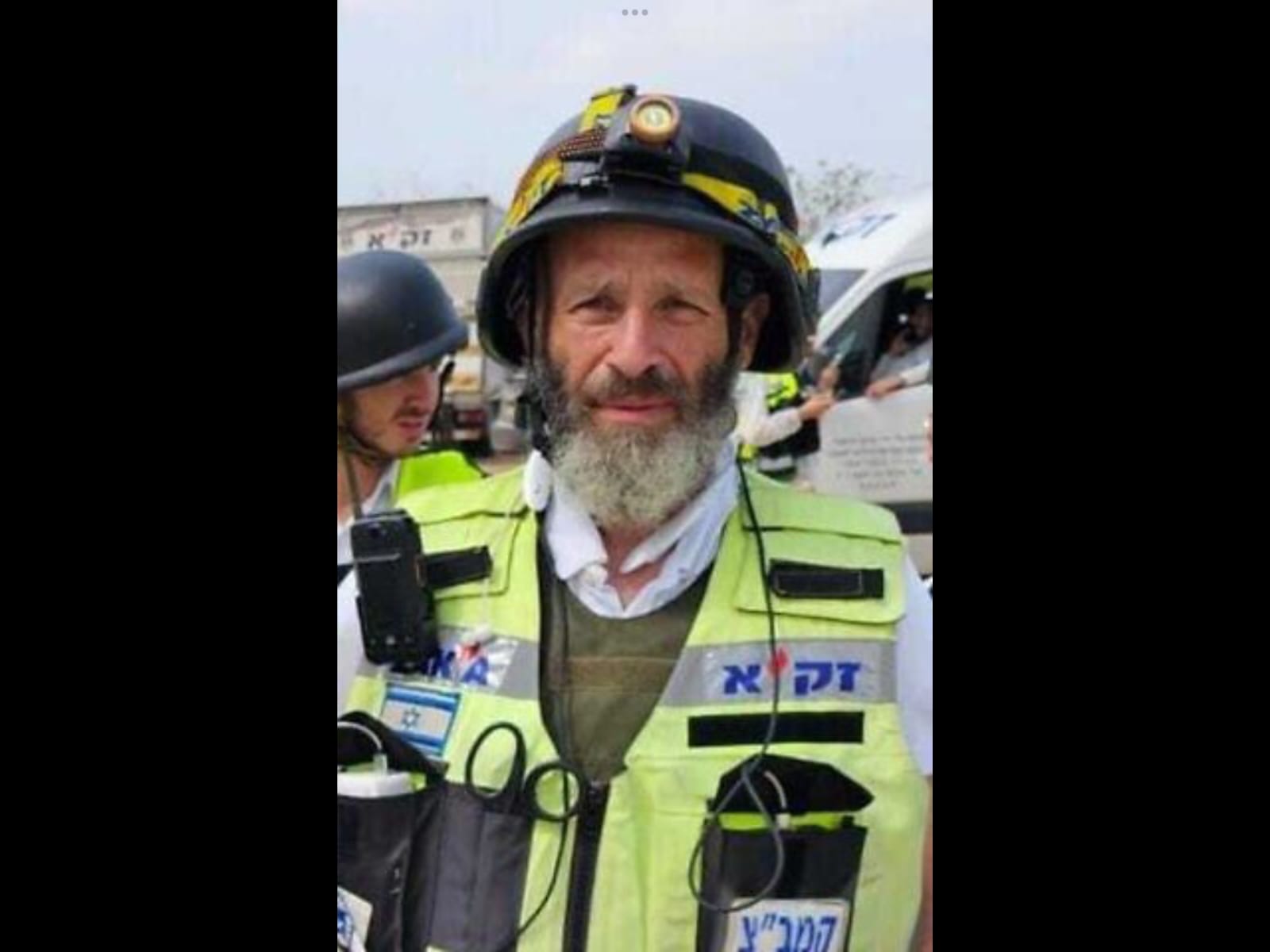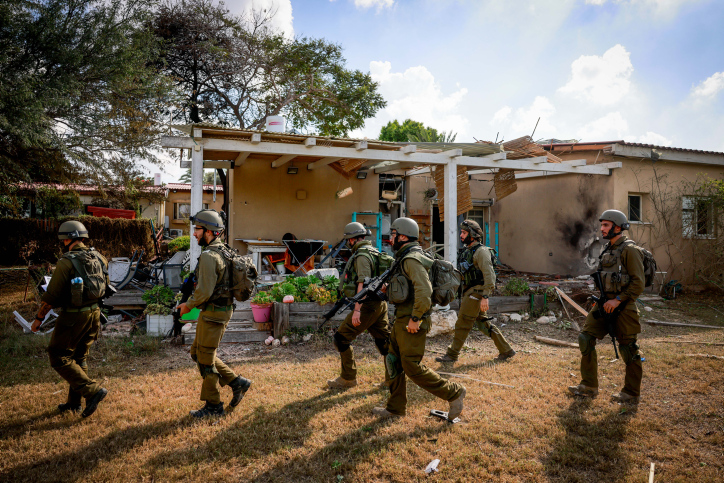"We Witnessed Sights Beyond Description": Rescue Forces and ZAKA Describe Their Sacred Work Amidst the Horror in the Southern Border Settlements
Rescue workers and Chevra Kadisha were among the first to arrive at disaster sites in the Gaza border settlements, facing horrific scenes while simultaneously saving lives and preparing the deceased for burial, often under fire. In an exclusive interview with 'Hidabroot,' four of them recount their experiences.
 Efraim Gridinger
Efraim GridingerYechezkel Rosenbaum, a volunteer with 'United Hatzalah,' received a call on the morning of Simchat Torah. As a dedicated volunteer, he quickly answered, expecting another isolated incident. "I couldn't believe what truly awaited me," he admitted in an interview with 'Hidabroot' after days of relentless effort, rushing from scene to scene to save as many lives as possible.
Rosenbaum, a seasoned volunteer, believed he had seen it all until last month. On Simchat Torah, he was among the first at a horrific scene where terrorists massacred hundreds in the border settlements, realizing he faced an unprecedented event.
At what point did you realize this was unlike anything you'd seen before?
"Initially, early in the morning, the sirens began. That was the first indication of a significant event, but I couldn't imagine its true scope. Then came a distressing call, directing me to the 'Volunteer House' to gather equipment to treat the wounded. It was then I realized this was not an event with few casualties. During the call, they also outlined the event's scale as they understood it at the time... Later, it became clear the disaster was even greater."
"Shortly after receiving the call, I was en route to the 'Volunteer House,' loaded up equipment, and headed to one of the most severe massacre sites on Route 232, which stretches behind Sderot, where many were killed."
Weren't you afraid to go there?
"At that moment, there's no time to dwell on such thoughts, as I'm focused on quickly reaching the area, alongside a dear colleague in the 'United Hatzalah' ambulance. Even then, I didn't grasp the event's full magnitude." Despite understanding later, Rosenbaum stayed and risked his life for the wounded.
What happens at the scene itself?
"We arrived at Route 232, unaware it was swarmed with terrorists. What I did see were the massacre's effects, in and around cars. Shocked, my friend and I rushed to report via zoom to 'United Hatzalah' management, so they'd realize the historic scale of the event."
"Meanwhile, we began treating the wounded on site; however, before disembarking the vehicle, a military jeep brought an injured civilian to us for treatment. We began resuscitation immediately, then transported him to Sderot to meet with an advanced life support unit before returning to the firefight area. Throughout, gunfire echoed around us, highlighting the danger—but there was no choice. At those moments, we were the only ones operating, as other rescue forces feared entering battleground zones."
Later, Rosenbaum reached some of the worst-hit areas: Be'eri and Kfar Aza. "We witnessed scenes I never imagined I would," he recounts. "The entire area looked like a warzone, scattered with RPG missiles, grenades, fire, and smoke. Amongst this, we witnessed forces capturing the terrorists and detaining them in Israel. Even reaching there was arduous. Vehicles and debris from the massacre littered the path, forcing us to weave between paths to reach the war zones. Shattered Hamas motorcycles and vehicles lined the sides."
 (Photo: Yaniv Nadav / Flash 90)
(Photo: Yaniv Nadav / Flash 90)How were you secured all that time?
"Despite being in the most dangerous areas, from Route 232 to the party area in Reim, initially, we arrived alone. We operated there, realizing later that there were active terrorists nearby. Eventually, entering Kfar Aza and Be'eri, we were accompanied by large military forces. The escort, numbering about 150 soldiers, definitely provided a sense of security. Yet, suddenly, vehicles from the Shin Bet appeared, updating us on terrorists' presence nearby. On one side were our forces, and on the other, the terrorists, forcing us to maneuver the situation: retreat, lie prone, and witness the battles."
"The difference between the first day and those following was that the IDF wasn't prepared on day one, caught by surprise," he explains. "As time passed, the military recovered and gained control of the area. This reflected in the rescue operations too; gradually, military rescue forces increased their presence, with armored military ambulances joining the effort, alongside rescue helicopters."
Did you encounter heroism stories from people you transported in the ambulance?
"Absolutely, there were. Around 2 PM on Simchat Torah, we transported four female soldiers to Soroka Hospital. En route, they recounted their fight with the terrorists. Not fully aware of who they faced, they bravely engaged in battle. When the terrorists arrived and threw grenades at them, the soldiers—armed only with their weapons—had to retreat, where they were wounded. Thankfully, they managed to hide under a pile of mattresses, avoiding capture."
After all these events, when did you finally return home?
"Association with the Home Front Command's rescue unit saw me called up for reserve duty by Monday. I reached the base and told my commander I had been actively involved since Simchat Torah morning. Exhausted, I returned home and fell asleep mid-conversation with my family... He understood and allowed me some rest before returning to duty."
How do you feel the day after?
"Psychologists from the resilience program spoke with us, advising us to write what we saw and experienced. Fortunately, I've had no flashbacks from those sights. But I suspect it's because there's simply no time to reflect. Even now, I'm treating new casualties from rockets and other security incidents."
Volunteers Leave Midway
Yossi Landau, a well-known ZAKA volunteer, explains in a conversation with 'Hidabroot' that the sights in the border settlements are unbearable, causing some volunteers to withdraw. "Those who can, work; those who can't, go home," he plainly states. "Out of my group of fifty volunteers, I had to withdraw three from sensitive operations. They just couldn't handle what they saw."
 Yossi Landau
Yossi LandauSince when have you been at the massacre sites?
"I arrived at one of the sites on Shabbat itself. We operated under fire, actively engaging," he notes. "Many ZAKA volunteers are trained, carrying handguns as part of learned lessons on arming civilians. Thankfully, except for one volunteer who was killed by a missile at his home, may Hashem avenge him, we had no other casualties."
"We worked tirelessly and hope these terrorists pay for their actions through their destruction," he concludes.
From Landau, we move to Efraim Gridinger, also a veteran ZAKA volunteer. "The event began for me on Saturday night," he explains, "joining the forces already in the border area. From there, they took us straight to the site of the Reim party, one of the loci of the massacre. The army likely didn’t know terrorists still lurked. Had they known, they probably wouldn’t have brought us there," he speculates.
How did you manage this large event?
"At the time, we only knew about the party incident. We didn't anticipate later having to reach homes throughout the area to perform the true kindness of burial preparation. On the second day, a senior military officer was killed nearby, having secured us just a day earlier. Notably, the security was very intense. At entry points to volatile areas, some hundred soldiers marched with us on each sortie to the settlements."
"Jewish casualties (distinct from Hamas terrorists) were loaded onto eight trucks. Tragically, the count increased with more victims of sanctifying Hashem's name. By 4 AM, we headed to Ofakim. We believed we'd cleaned the area of casualties, but in the coming days, reality shattered this belief," he reflects somberly.
"Since then, we've necessarily returned, continuing non-stop efforts to prepare Jews for burial and ensure the respect of the deceased."
How is your cooperation with the IDF?
"Sadly, often we had to inform the military where to venture, after families reached out about loved ones believed to be in specific places across the area. Receiving such inquiries underscored the profound despair," he shares.
 (Photo: Haim Goldberg / Flash 90)
(Photo: Haim Goldberg / Flash 90)Not far, in the city of Netivot, which also suffered significantly from Hamas militants' incursion into its western sector, resides Rabbi Binyamin Malka, a Chevra Kadisha and ZAKA member. "Despite my many years in duty, I struggle to recover from what I've seen," he admits. "We've handled nearly 70 deceased. Forty perished in city events; others were brought from the border settlements' massacre sites. I've lived here for years and have never seen anything like this."
During the festival, he arrived at the command center to manage the incident, walking a significant distance donning a ceramic vest and helmet. "I stayed until 5 AM," he recounts. "Regrettably, what I witnessed was severe. The state of bodies wasn't easy. There were casualties everywhere, including two found on a rooftop, trying to escape terrorists, tragically targeted and murdered."
May Hashem wipe away every tear from every face.

